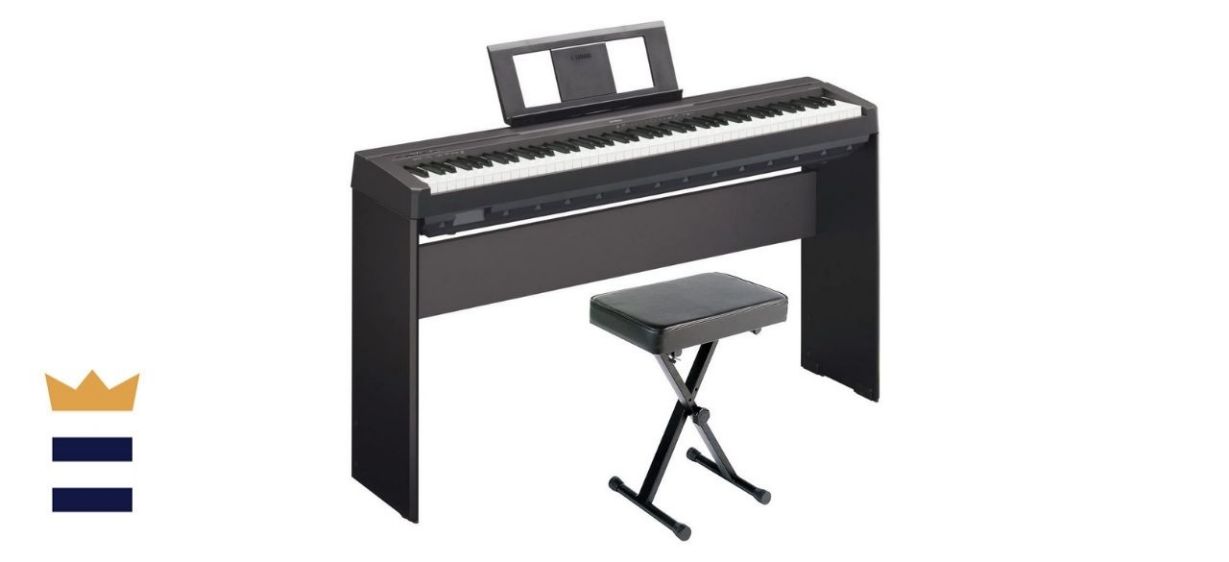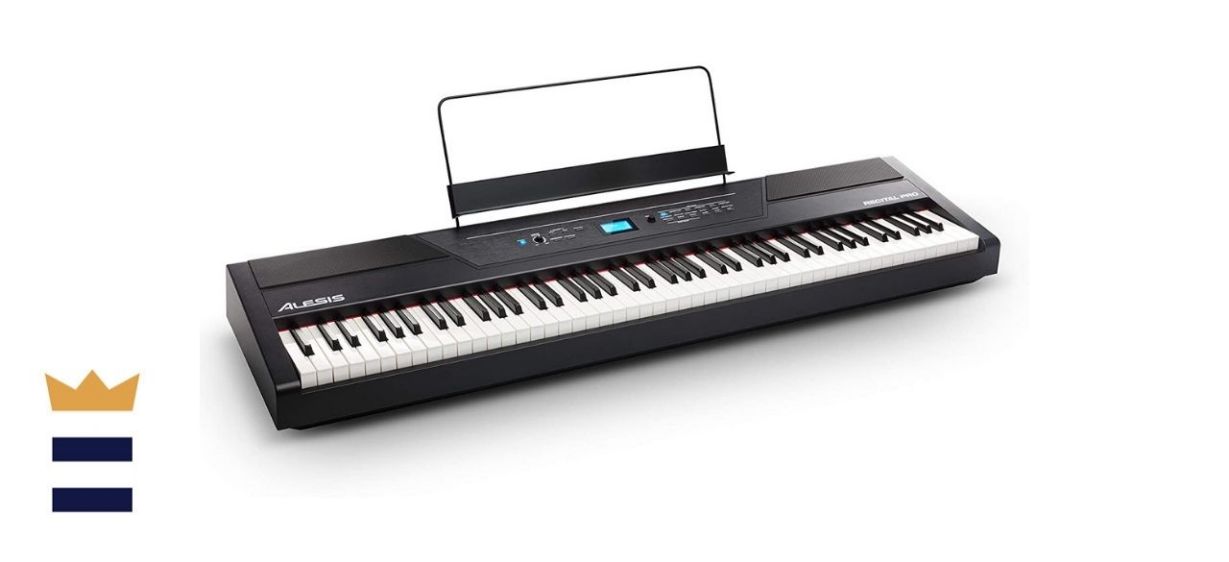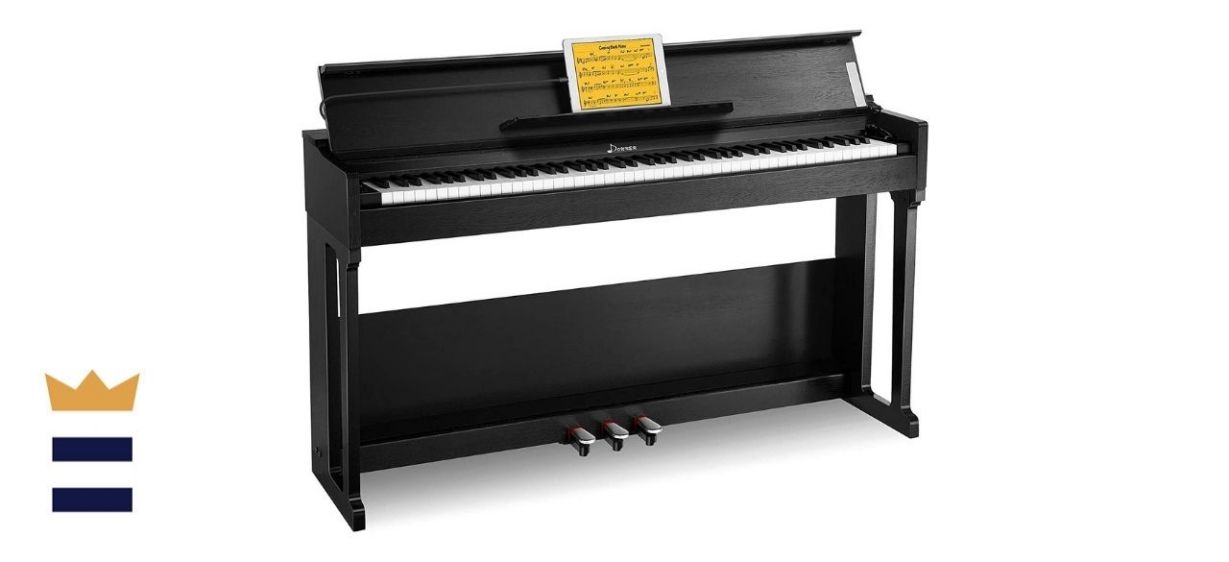Which digital keyboard is best?
Acoustic pianos are one of the most beautiful instruments you can buy, in looks and sound. However, they’re difficult to maintain and expensive. A digital keyboard can create nearly identical sounds as many use samples from acoustic pianos. They require no maintenance and many are able to play more than just acoustic piano sounds.
The best digital keyboard is the Yamaha P45 88-Key Digital Weighted Piano. It includes all the accessories you need to set up your music station and has a solid polyphony and range of ports.
What to know before you buy a digital keyboard
Digital keyboard types
There are two main types of digital keyboard: standard and synthesizer.
- Standard digital keyboards are built to be as identical to an acoustic keyboard as possible. They achieve this in both design and sound. In design terms, they use a full set of 88 keys, and occasionally pedals, which are weighted and sized closely to acoustic standards. For sound, they play back recordings of acoustic pianos. Many offer additional soundscapes like those from organs as well as brass and string instruments. These keyboards are designed for the burgeoning and/or traveling professional.
- Synthesizers can create more kinds of music but have less precise control over the music. They are usually made with fewer keys and often include the ability to make tracks using built-in music like baselines or rhythms. These are best for personal use rather than professional.
Key aspects
The two aspects of digital keys worth examining are their action and touch sensitivity.
- Action: Action refers to how hard you need to press a key for it to produce music. Digital keys use various methods to create a level of resistance that feels good for the pianist. Keys with good action can be played comfortably, without needing too heavy or light of a touch.
- Touch sensitivity is only available on high-quality digital keyboards. This ability allows a digital keyboard to play harder or lighter sounds based on the force the pianist places on the keys, much like an acoustic piano allows.
What to look for in a quality digital keyboard
Polyphony
The polyphony of a digital keyboard is the number of pitches that can be sustained at once before sounds begin to drop. The higher the polyphony, the richer and more detailed a sound your digital keyboard can create.
Ports
Digital keyboards frequently include a number of ports that enable input or output to other devices. Common ports include headphone jacks and ports to connect to external speakers. Professionals should look for a digital keyboard with ports to amplifiers and mixing boards while beginners should check for USB ports to connect to learning services and software.
Pedals
Acoustic pianos use foot pedals to alter the sounds they create in various ways. Some digital keyboards include these pedals natively or include support for adding them after purchase. Some digital keyboards utilize only one pedal rather than three.
How much you can expect to spend on a digital keyboard
Like many electronic devices, digital keyboards can be as expensive or affordable as you desire. Most entry-level keyboards start around $300, with the best-of-the-best synthesizers reaching or exceeding $3,000.
Digital keyboard FAQ
What are the benefits of using a digital keyboard?
A. There are many benefits to using a digital keyboard over an acoustic piano. The two biggest benefits are digital keyboards are lightweight, making them easy to travel with, plus the need for maintenance and tuning is greatly decreased. They can also be easier for beginners to learn on. Some digital keyboards can even be connected to educational services for guided learning.
What are the negatives of using a digital keyboard?
A. There are fewer negatives than positives, but the negatives can be more severe for certain pianists. The biggest is the difference in feel and number of keys. Digital piano keys lack the weight of their acoustic counterparts and they may not have the full 88 keys either. This can make swapping between acoustic and digital keyboards frustrating. The other point is that no matter the quality of the output digital source, it can’t fully live up to the quality of natural acoustic sound.
What’s the best digital keyboard to buy?
Top digital keyboard
Yamaha P45 88-Key Digital Weighted Piano
What you need to know: This digital keyboard comes with all the accessories you need to complete your first setup.
What you’ll love: This package includes the P45 digital keyboard, the L85 furniture stand, the PKBB1 bench and a sustain pedal. The keys and the sounds the keyboard creates are identical to a grand piano. A USB port allows connection to various services and software.
What you should consider: The keys can have a “click” sound to them that trained ears may find distracting. Some consumers had issues with the stand being improperly sized.
Where to buy: Sold by Amazon
Top digital keyboard for the money
Alesis Recital Pro Digital Piano
What you need to know: This budget digital keyboard still includes plenty of features and functions
What you’ll love: The keys are weighted for added realism. It can create 13 sound types including piano, organ and synthesizer. It has several educational modes for beginner and intermediate pianists alike, plus includes a three-month skoove subscription. The built-in speakers are high quality.
What you should consider: It doesn’t come with any accessories so you’ll need to shop for a stand and bench if you don’t already have them.
Where to buy: Sold by Amazon
Worth checking out
What you need to know: This digital piano mimics the look and feel of an acoustic piano.
What you’ll love: The keys are fully weighted, but can have their touch response adjusted. It uses sound samples taken from acoustic grand pianos. The 128 polyphony prevents sounds from being dropped. It has a three-pedal system. The flip cover uses a resistance hinge to close slowly, preventing finger damage.
What you should consider: It does not include a bench. Music still outputs from the speaker even with headphones plugged in. Some consumers had issues with peeling paint.
Where to buy: Sold by Amazon
Sign up here to receive the BestReviews weekly newsletter for useful advice on new products and noteworthy deals.
Jordan Woika writes for BestReviews. BestReviews has helped millions of consumers simplify their purchasing decisions, saving them time and money.
Copyright 2022 BestReviews, a Nexstar company. All rights reserved.




